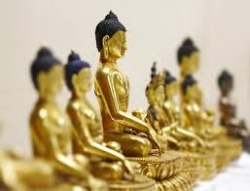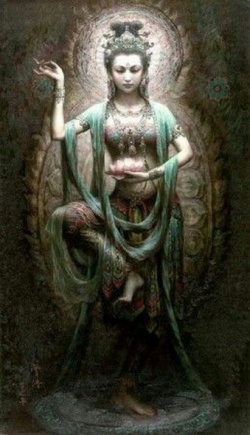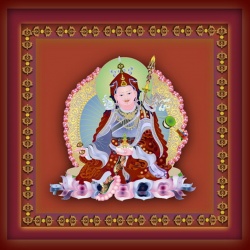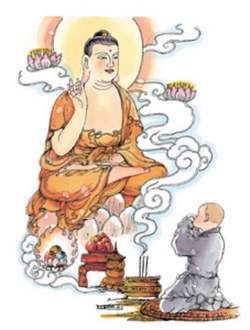Vajrasattva
Vajrasattva (Sanskrit: वज्रसत्त्व, Tibetan:རྡོ་རྗེ་སེམས་དཔའ། - Short form is "dorsem" རྡོར་སེམས is a bodhisattva in the Mahayana, Mantrayana/Vajrayana Buddhist traditions. In the Japanese Vajrayana school of
Buddhism, Shingon, Vajrasattva is the esoteric aspect of the bodhisattva Samantabhadra and is commonly associated with the student practitioner who through the master's teachings, attains an ever-enriching subtle and rarefied grounding in their esoteric practice. In Tibetan Buddhism Vajrasattva is associated with the sambogakaya and also with purification practice.
Vajrasattva appears principally in two Buddhists texts: the Mahavairocana Sutra and theVajrasekhara Sutra. In the Diamond Realm Mandala, Vajrasattva sits to the East near Akshobhya Buddha.
In some esoteric lineages, Nagarjuna was said to have met Vajrasattva in an iron tower in South India, and was taught tantra, thus transmitting the esoteric teachingsto more historical figures.
Nomenclature, orthography and etymology
Vajrasattva' (Standard Tibetan: Dorje Sempa, Japanese: Kongōsatta, Chinese: 金剛薩埵 Jīn gāng sà duǒ) is a bodhisattva in the Mahayana and Vajrayana buddhist traditions. Vajrasattva's name translates to Diamond Mind or Thunderbolt Mind.
Shingon Buddhism
In the Shingon Buddhist lineage, Vajrasattva is traditionally viewed as the second patriarch, the first being Vairocana Buddha himself. According to Kukai's writings in Record of the Dharma Transmission he relates a story based on Amoghavajra's
account that Nagarjuna met Vajrasattva in an iron tower in southern India. Vajrasattva initiated Nagarjuna into the abhiseka ritual and entrusted him with the esoteric he had learned from Vairocana Buddha, as depicted in the Mahavairocana Sutra. Kukai does not elaborate further on Vajrasattva or his origins.
Elsewhere, Vajrasattva is an important figure in two esoteric Buddhist sutras, the Mahavairocana Sutra and the Vajrasekhara Sutra. In the first chapter of the Mahavairocana Sutra, Vajrasattva leads a host of beings who visit Vairocana Buddha to learn the Dharma. Vajrasattva inquires about the cause, goal and foundation of all-embracing wisdom, which leads to a philosophical
discourse by the Buddha. The audience cannot comprehend the teaching, so the Buddha demonstrates through the use mandala. Vajrasattva then questions why rituals and objects are needed if the truth is beyond form. Vairocana Buddha replies to
Vajrasattva that these are expedient means to bring practitioners to experience awakening more readily, and so on. In [[Shingon
Buddhist]] rituals for initiation, the kechien kanjō, the initiate re-enacts the role of Vajrasattva and recites mantra and dialogue from the sutras above. The Maha Acharya enacts the role of Mahavairocana Buddha bestowing wisdom upon the student.
Tibetan Buddhism
In Tibetan Buddhism the Vajrasattva root tantra is Dorje Gyan, or "Vajra Ornament". Vajrasattva practices are common to all of the four schools of Tibetan Buddhism and are used both to purify obscurations so that the Vajrayana student can progress
beyond Ngondro practices to the various yoga practices of tantra and also to purify any broken samaya vows after initiation. As such, Vajrasattva practice is an essential element of Tibetan Buddhist practice.
In addition to personal practice, the Vajrasattva mantra is regarded as having the ability to purify karma, bring peace, and cause enlightened activity in general. Following the September 11, 2001 attacks on the United States, The Dzogchen Ponlop Rinpoche announced a project, Prayer 4 Peace, to accumulate one billion six syllable Vajrasattva recitations by practitioners
around the world. The six syllable mantra (OM VAJRASATTVA HUM), is a less formal version of the one hundred syllable mantra on which it is based but contains the essential spiritual points of the longer mantra, according to lama and tulku Jamgon Kongtrul.
Vajrasattva; (Adi-Buddha)
(Whose essence is the Thunderbolt).
Buddha of Supreme Intelligence.
(T.) rdo-rje sems-dpah (soul of the thunderbolt).
(C.) Suan-tzu-lo-sa-tsui (Suan Tzu Lo Sa Tsui).
(J.) Kongosatta (essence of a diamond).
Symbols: vajra (thunderbolt), ghanta (bell).
Colour: white.
Bodhisattva of Akshobhya (Dhyani-Buddha) and chief (Tsovo) or president of the five Dhyani-Buddhas.
The position of Vajrasattva in the Mahayana pantheon is difficult to determine. He is looked upon as the spiritual son of Akshobhya, and is at the same time Tsovo or chief of the five Dhyani-Buddhas. M. de la Vallee Poussin identifies him with Vajradhara. Eitel calls him the sixth Dhyani-Buddha of the Yogacharya school. 16
The Svabhavika sect in Nepal identified Svabhava 17 (Adi-Buddha) with Vajrasattva, who, according to the Nepalese Buddhist writings, manifested himself on Mount Sumeru in the following manner. A lotus-flower of precious jewels appeared
on the summit of the mountain which is the centre of the universe, and above it arose a moon-crescent upon which, 'supremely exalted', was seated Vajrasattva.
It is not probable that the image of the AdiBuddha Vajrasattva is here meant, but rather the symbol which designates the Adi-Buddha, a light-shaped flame. If the moon-crescent, which arose above the lotus-flower, is represented with the flame symbol in the centre, instead of the 'image of Vajrasattva', it forms a trident. 18 The special emblem of the Svabhavika sect was a trident rising
from a lotus-flower, which, if we accept the above hypothesis, symbolized the manifestation of Vajrasattva as Adi-Buddha on Mount Sumeru.
In the Musee Guimet there is an example of a Bodhisattva (or 'crowned' Buddha), with four heads19 seated, with the legs locked, and balancing a vajra on his hands in dhydna mudra. As the Adi-Buddhas are always represented with the Bodhisattva ornaments, it may be a representation of Vajrasattva as Adi-Buddha; and since Brahma, chief of all the Brahman gods, has four heads, the idea of
representing Vajrasattva in the same manner may have been borrowed from Brahmanism to distinguish Vajrasattva as Adi-Buddha, chief of all the gods of the Mahayana system, from his manifestations which occupy a less exalted position in the Northern Buddhist pantheon.
As sixth Dhyani-Buddha, Vajrasattva presides over the Yidam, 20 and has the same relation to the Adi-Buddha that the Manushi (human) Buddha has to his ethereal counterpart or Dhyani-Buddha. The sixth sense is believed to have emanated from him, as well as the last of the six elements of which man is composed — the manas, or mind (v. Tlie Dhyani-Buddhas).
Vajrasattva is always represented seated, wearing the five-leaved crown and the dress and ornaments of a Dhyani-Bodhisattva. He generally holds the vajra against his breast with the right hand, but the vajra may be held in the hand or balanced on its point in
the palm of the hand. With the left, he holds the gJmnta on his hip . When seated on a white lotus, he is looked upon by certain sects as Guardian of the East. 21
Unlike the other Dhyani-Buddhas, he is always crowned with or without his sakti, whom he presses against his breast in the yab-yum 22 attitude, with the right hand holding the vajra, while the left holds the ghanta on his hip. The yum holds the kapala (skull-cup) and vajra.
[Page 6] In Nepal, according to Hodgson, he is seldom represented in statuary form, but is more often met with in paintings, and especially in miniatures. In Tibet, however, bronzes of Vajrasattva are not infrequently found, while in paintings, especially in mandala, 23 he is often
met with. In Japan he is found in statues as well as in paintings, and is called 'Kongosatta'. The Japanese look upon Trailokya-vijaya Bodhisattva as a form of Vajrasattva.
Hundred Syllable Mantra
In Tibetan Vajrayana Buddhist practice, Vajrasattva is used in the Ngondro, or preliminary practices, in order to purify the mind's defilements, prior to undertaking more advanced tantric techniques. The yik gya, the "Hundred Syllable Mantra" (Tibetan: ཡིག་བརྒྱ, Wylie: yig brgya) supplication of Vajrasattva, approaches universality in the
various elementary Ngondro sadhana for sadhakas of all Mantrayana and Sarma schools bar the Bonpo. The pronunciation and orthography differ between lineages.
སུ་ཏོ་ ཥྱོ་མེ་བྷ་བ།
སུ་པོ་ ཥྱོ་མེ་བྷ་བ།
ས་རྦ་ཀ་རྨ་སུ་ཙ་མེ ཙི་ཏྟཾ༌ཤེ་ཡཿ་ཀུ་རུ་ཧཱུྂ།
བྷ་ག་བ་ན
ཨཱཿ །། ཧཱུྂ ཕ་ཊ
Oṃ (1)
Vajrasattva (5) samaya (8)manupālaya (13) |
Vajrasattva (17) tvenopatiṣṭha (22) |
Dṛḍho me bhava (27) |
Sutoṣyo me bhava (33) |
Supoṣyo me bhava (39) |
Anurakto me bhava (46) |
Sarva siddhiṃ (50) me prayaccha (54) |
Sarvakarmasu (59) ca me (61)
Hā hā hā hā hoḥ (73)
Bhagavan (76)
sarva (78) Tathāgata (82) Vajra (84)mā me muñca (88) |
Vajra bhava (92) mahāsamaya (97) sattva āḥ (100) ||
O Vajrasattva honour the agreement!
Reveal yourself as the vajra-being!
Be steadfast for me!
Be very pleased for me!
Be fully nourishing for me!
Be passionate for me!
Grant me all success and attainment!
And in all actions make my mind more lucid!
ha ha ha ha hoḥ
O Blessed One, vajra of all those in that state, don't abandon me!
O being of the great contract be a vajra-bearer!
(The most excellent exclamation of praise)
Vajrasattva’s Samaya: O Vajrasattva, protect the Samaya
May you remain firm in me
Grant me complete satisfaction
Grow within me (increase the positive within me)
Be loving towards me
Grant me all the siddhis
Show me all the karmas (activities)
Make my mind good, virtuous and auspicious!
(The heart essence, seed syllable of Vajrasattva)
(Symbolises the four immeasurables, the four
empowerments, the four joys, and the four kayas)
(The exclamation of joy at this accomplishment)
O blessed one, who embodies all the Vajra Tathagatas
Do not abandon me
Grant me the realization of the Vajra Nature
O great Samayasattva
Make me one with you
Longchen Nyingtig
The evocation of the Hundred Syllable Mantra in the Mantrayana lineage of Jigme Lingpa's (1729–1798) Ngondro from the Longchen Nyingtig sports Sanskrit-Tibetan hybridization, such textual and dialectical diglossia (Sanskrit: dvaibhashika) is evident
from the earliest transmission of tantra into the Himalaya where the Sanskrit phonemes and lexical items are often orthographically rendered in the Tibetan, rather than the comparable indigenous terms (Davidson, 2002). Though Jigme Lingpa did not compose the
[[Hundred Syllable Mantra, his scribal style bears a marked similarity to it as evidenced by his biographies (Gyatso, 1998). Jigme Lingpa as pandit, which in the Himalayan context denotes an indigenous Tibetan versed in Sanskrit, often wrote in a hybridized Sanskrit-Tibetan diglossia.
Dzogchen
"The Mirror of the Heart of Vajrasattva" (Tibetan: རྡོ་རྗེ་སེམས་དཔའ་སྙིང་གི་མེ་ལོང, Wylie: rdo rje sems dpa' snying gi me long) is one of the Seventeen Tantras of Dzogchen Upadesha.
Samantabhadra discourses to Vajrasattva and in turn Vajrasattva asks questions of Samantabhadra in clarification in the Kulayaraja Tantra (Wyl. kun byed rgyal po; Tib. künjé gyalpo) or "The All-Creating King Tantra", the main tantra of the Mind Series of Dzogchen.
Consorts
Vajrasattva is often depicted with various consorts, the peaceful one Vajragarvi aka Vajrasattvātmikā (Tib. Dorje Nyema), Dharmadhatvishvari, Ghantapani ("Bell Bearer"), the wrathful one Diptacakra, Vajratopa, Vajrabhrikuti, and others.








